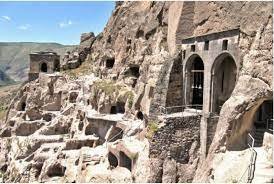Georgia’s landscape whispers tales of a bygone era, and its cave cities stand as silent guardians of these ancient secrets. While Uplistsikhe whispers of 3,000-year-old kingdoms, David Gareja echoes with 6th-century monastic chants, and Samshvilde’s dwellings lie forgotten, none captivate the soul quite like Vardzia.
Carved into the slopes of Mount Erusheti, overlooking the Mtkvari River, Vardzia emerges as a marvel of human ingenuity. In its prime, this rock-hewn metropolis boasted 6,000 chambers spread across 19 dizzying levels, encompassing a vibrant medieval city and monastery. Imagine 25 wine cellars overflowing with ruby-red vintages, a serene nunnery, 15 chapels whispering with prayers, and an apothecary stocked with ancient remedies – all woven into the mountain’s embrace.
This wasn’t merely a haven for the devout; it was a fortress born of necessity. In the 12th century, King Giorgi III envisioned a stronghold, but it was his daughter, the legendary Queen Tamar, who truly brought Vardzia to life. Under her watchful eye, labyrinthine caves and chambers were carved deep into the mountain, including a secret escape tunnel and a web of dead-end halls to confound invading armies.
From a modest fortress, Vardzia blossomed into a thriving hub. It housed 2,000 monks, sheltered tens of thousands of residents, and thanks to its fertile terraces and a sophisticated irrigation system, became a self-sufficient wonder long before its time. Queen Tamar, fierce and powerful, earned the title of King Tamar Mepe. Her near 30-year reign saw Georgia flourish, expanding across the Caucasus and solidifying its cultural tapestry.
However, glory rarely endures without scars. A devastating earthquake in 1283 ripped through the region, severing the outer wall and leaving an avalanche of destruction. Without its formidable defense, Vardzia’s residents scattered, leaving only the unwavering monks to tend to the echoes of its former grandeur. For another 300 years, the monastic community held on, until further raids forced them to abandon their mountain sanctuary.

Yet, history has a way of circling back. Today, a handful of monks reclaim Vardzia’s spirit, breathing life back into its hallowed halls after the fall of the Soviet Union. Around 500 caves remain, each whispering tales of the past. Explore an apothecary with intact shelves, wine cellars where ancient qvevris (wine-making vessels) lie buried in time, and delve deeper into the mountain’s heart to discover a labyrinth of untouched tunnels, some stretching 600 feet – a silent testament to a forgotten era.
Feast your eyes on the timeworn dining hall, its benches carved from stone and a hearth ready to bake bread for a long-gone community. The most striking structure is the massive bell tower, perched atop a rock shelf. Though shorn of its original bell by Mongol raiders, it retains its imposing air.
But the soul of Vardzia resides in the Church of the Dormition, its double-arched portico impossibly carved into the mountain face. Inside, weathered frescoes tell stories in silent hues, including one of only four depictions of Queen Tamar in existence. Legend seekers can embark on a quest for the Tears of Queen Tamar, a hidden spring within the tunnels where water drips from the rocks, seemingly mourning the city’s fall.
Beyond Vardzia, Samtskhe-Javakheti unfolds its treasures. Opposite Vardzia, the Vardzia Cavetown Viewpoint rewards you with a panoramic vista. Then, there’s Vanis Kvabebi, a 5th-century monastery carved into the mountainside, offering climbers wooden ladders that lead to a tiny white domed church and breathtaking valley views. For a dose of medieval grandeur, Tmogvi Fortress sprawls above the river, its ruins whispering of forgotten citadels, frescoes, and crumbling towers.
On your way back to Tbilisi, don’t miss Khertvisi Fortress, a medieval castle dominating a rocky outcrop. Further south, Borjomi beckons with its dense forests, healing mineral springs, and legendary hangover-curing bottled water. Akhaltsikhe, dominated by the diverse tapestry of Rabati Castle, is a treasure trove of history, showcasing a mosque, a synagogue, and an orthodox church within its walls.
And finally, Paravani Lake, Georgia’s largest, nestles amidst volcanic mountains, offering windswept beauty and a glimpse into Georgian history at the St. Nino Nunnery, where nuns craft artisanal chocolates, cheese, and even qvevri-brewed beer.
Travel to Europe
Coach rental in Europe
Travel agency Paris
DMC for Europe
DMC for Paris
